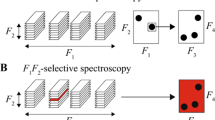Abstract
NMR spectroscopy is intrinsically insensitive, a frequently serious limitation especially in biochemical applications where sample size is limited and compounds may be too insoluble or unstable for data to be accumulated over long periods. Fourier transform (FT) NMR was developed by Ernst1 to speed up the accumulation of useful data, dramatically improving the quality of spectra obtained in a given observing time by recording the free induction decay (FID) data directly in time, at the cost of requiring numerical processing. Ernst also proposed that more information could be obtained from the spectrum if the FID was multiplied by a suitable apodizing function before being Fourier transformed. For example (see ref. 2), an increase in sensitivity can result from the use of a matched filter1, whereas an increase in resolution can be achieved by the use of gaussian multiplication1,3, application of sine bells4–8 or convolution difference9. These methods are now used routinely in NMR data processing. The maximum entropy method (MEM)10 is theoretically capable of achieving simultaneous enhancement in both respects11, and this has been borne out in practice in other fields where it has been applied. However, this technique requires relatively heavy computation. We describe here the first practical application of MEM to NMR, and we analyse 13C and 1H NMR spectra of 2-vinyl pyridine. Compared with conventional spectra, MEM gives considerable suppression of noise, accompanied by significant resolution enhancement. Multiplets in the 1H spectra are resolved better leading to improved visual clarity.
Similar content being viewed by others
References
Ernst, R. R. Advances in Magnetic Resonance Vol. 2, 1–135 (Academic, New York, 1966).
Lindon, J. C. & Ferrige, A. G. Prog. Nucl. Magn. Reson. Spectrosc. 14, 27–80 (1980).
Ferrige, A. G. & Lindon, J. C. J. magn. Reson. 31, 337–340 (1978).
De Marco, A. & Wüthrich, K. J. magn. Reson. 24, 201–204 (1976).
Gueron, M. J. magn. Reson. 30, 515–520 (1978).
Clin, B., De Bony, J., Lalanne, P., Biais, J. & Lemanceau, B. J. magn. Reson. 33, 457–463 (1979).
Lohmann, J. A. B. J. magn. Reson. 38, 163–167 (1980).
Brereton, R. G., Garson, M. J. & Staunton, J. J. magn. Reson. 43, 224–233 (1981).
Campbell, I. D., Dobson, C. M., Williams, R. J. P. & Xavier, A. V. J. magn. Reson. 11, 172–181 (1973).
Gull, S. F. & Daniell, G. J. Nature 272, 686–690 (1978).
Sibisi, S. Nature 301, 134–136 (1983).
Shore, J. E. & Johnson, R. W. IEEE Trans. Inform. Tech. IT-26, 26–37 (1980); IT-29, 942–943 (1983).
Livesey, A. K. & Skilling, J. Acta crystallogr. A (in the press).
Burg, J. P. thesis, Stanford Univ. (1975).
Ulrych, T. J. & Bishop, T. N. Rev. Geophys. Space Phys. 13, 183–200 (1975).
Fougere, P. J. geophys. Res. 82, 1051–1054 (1977).
Skilling, J. & Gull, S. F. SIAM Am. Math. Soc. Proc. 14, 167–189 (1984).
Scott, P. F. Mon. Not. R. astr. Soc. 194, 25P–29P (1981).
Tuffs, R. J. thesis, Cambridge Univ. (1984).
Frieden, B. R. J. opt. Soc. Am. 73, 927–938 (1983).
Redfield, A. G. & Kunz, S. D. J. Magn. Reson. 19, 250–254 (1975).
Skilling, J. & Bryan, R. K. Mon. Not. R. astr. Soc. (in the press).
Author information
Authors and Affiliations
Rights and permissions
About this article
Cite this article
Sibisi, S., Skilling, J., Brereton, R. et al. Maximum entropy signal processing in practical NMR spectroscopy. Nature 311, 446–447 (1984). https://doi.org/10.1038/311446a0
Received:
Accepted:
Issue Date:
DOI: https://doi.org/10.1038/311446a0
- Springer Nature Limited
This article is cited by
-
T2* weighted Deconvolution of NMR Spectra: Application to 2D Homonuclear MAS Solid-State NMR of Membrane Proteins
Scientific Reports (2019)
-
Accurate determination of rates from non-uniformly sampled relaxation data
Journal of Biomolecular NMR (2016)
-
Sensitivity gains, linearity, and spectral reproducibility in nonuniformly sampled multidimensional MAS NMR spectra of high dynamic range
Journal of Biomolecular NMR (2014)
-
Analysis of fluorescence decay kinetics of thioflavin t by a maximum entropy method
Journal of Applied Spectroscopy (2010)
-
Automatic maximum entropy spectral reconstruction in NMR
Journal of Biomolecular NMR (2007)





